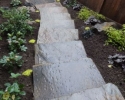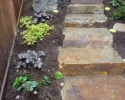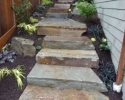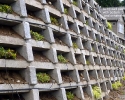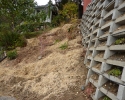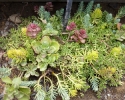By MARTY WINGATE – SPECIAL TO THE POST-INTELLIGENCER
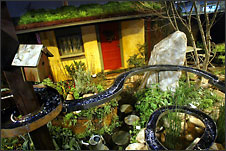
In the water-collection system, recycled sheet metal forms the troughs that channel harvested rainwater, which tumbles and dances over washed recycled glass on its way to a pond.
Gardeners will find inventive fun at this year’s Seattle P-I/Seattle Tilth display, “Harvesting the Rain,” at the Northwest Flower & Garden Show. Visitors can garner ideas on design and water conservation, find resources and uses for recycled materials, and admire the range of native plants that can be used to good effect in the garden.
Dominating the garden is the overall theme of rain conservation — designer Cameron Scott of Exteriorscapes created the kind of water-collection system that you would want front and center in your garden.
The system collects water runoff from gutters into a 600-gallon, above-ground cistern with a stylish wooden exterior. Water flows from the cistern along a series of metal troughs to a pond filled with scouring rush (Equisetum hyemale) below.
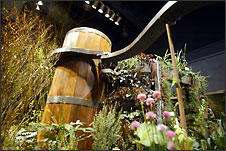
Water runoff from gutters is collected in a 600-gallon cistern with a stylish wooden exterior. The cistern is the answer to a perennial local problem: Although plentiful during the winter, rainfall is scarce in the summer.
The large storage cistern is the answer to a perennial local problem: Although plentiful during the winter, rainfall is scarce in the summer. That has prompted gardeners to collect large amounts of water in the wet months to be used in drier times. Rain barrels, unfortunately, don’t hold much — an average size holds 75 gallons. Scott’s cistern, on the other hand, can hold enough to carry an average-size garden through several dry weeks.
Even better, the system is good-looking and earth-friendly. The cistern is made from handsome dark-wood planks. The wood is ipe (pronounced EE-pay), a hardwood that wears similar to teak. The ipe is from Brazil and is certified by the Forest Stewardship Council, a guarantee that the wood was sustainably grown and harvested.
Water runoff from gutters is collected in a 600-gallon cistern with a stylish wooden exterior. The cistern is the answer to a perennial local problem: Although plentiful during the winter, rainfall is scarce in the summer.
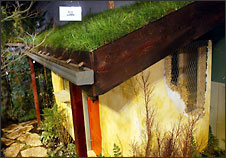
A living roof -- a mix of lawn grasses and broadleaf evergreens -- is good-looking and hard-working. It's a natural biofilter, reducing the amount of rain-carried pollutants, and it cools in summer and insulates in winter.
Recycled sheet metal forms the troughs that channel the water. They form a kind of raceway where you might expect to see Matchbox cars, but instead, water tumbles and dances over washed recycled glass on its way to the pond. As Scott says, “We have water for eight months of the year; it might as well entertain us.”
Below the water raceway are raised beds made of matching recycled sheet metal; their curves echo the trail of water. The metal has taken on an earthy patina as it has aged, and the muted tints of bronze and purple fit perfectly with the plant palette.
Sarah Bishop of Lowell Garden Design has accomplished her task of showcasing a mix of ornamentals and Northwest natives in this small urban garden. In a new take on the “living wall” concept, Bishop and Scott have stacked hanging baskets from sheet metal. The baskets are secured on hooks, allowing them to swing gently.
Foliage fills the metal baskets. Two coral bells provide color — the deep purple leaves of Heuchera americana ‘Stormy Seas’ and the green and pewter leaves of the cultivar ‘Green Spice.’ The bronze, flowing form of the New Zealand sedge Carex flagellifera and upright accents of the spiky New Zealand flax Phormium tenax ‘Apricot Queen’ are effective foils to the rounded forms of the coral bells.
A living roof — a mix of lawn grasses and broadleaf evergreens — is good-looking and hard-working. It’s a natural biofilter, reducing the amount of rain-carried pollutants, and it cools in summer and insulates in winter.
Natives sit comfortably beside these ornamentals. Evergreen shrubs show gardeners that a plant doesn’t have to be a conifer to be green year-round. Huckleberry (Vaccinium ovatum), Oregon boxwood (Pachistima myrsinites), lingonberry (Vaccinium vitis-idaea var. minus), hairy manzanita (Arctostaphylos columbiana) and creeping mahonia (Mahonia repens) join forces with better-known salal (Gaultheria shallon), Oregon grape (Mahonia aquifolium) and kinnikinnik (Arctostaphylos uva-ursi).
Shots of bright color give the garden extra zing, including the yellow and red stems of rainbow swiss chard, plus sunny daffodils and mahonia in bloom.
Vegetables and herbs are tucked into the landscape everywhere. Giant leeks and artichokes prove plants can be architectural and taste good, too. Tricolor, big leaf and purple sage add aroma. “We must have a dozen different kinds of thyme,” Bishop says.
The garden includes winter savory, tarragon, mints and more.
No urban-garden display would be complete without including the house — here an environmentally friendly structure made of straw bales covered by stucco (with a bit of the stucco peeled away so you can see how it was made).
Atop the house is a living roof — a mix of lawn grasses and broadleaf evergreens that is more than good-looking; it’s hard-working, too. A living roof is a natural biofilter, reducing the amount of rain-carried pollutants that make it to the pond below (or our ground water). The roof also cools in summer and insulates in winter.
On the garden shed is a living roof of another kind — native licorice ferns (Polypodium glycyrrhiza), salvaged from a site about to be logged.
In another turn on recycling, Bishop and Scott have incorporated part of the P-I/Tilth garden from last year’s show, which won the People’s Choice Award. In 2003, the core of the living wall was a large piece of road grating, and this year part of that metal was cut and bent to form the window and door trims. Instead of the usual wooden trim, these trims are soft and fuzzy, because they are planted. Around the window, tufts of blue fescue (Festuca glauca) are tucked into the holes of the grating, and around the door, it’s black mondo grass (Ophiopogon planiscapus ‘Nigrescens’).
Ideas abound at the garden, so be sure to carry pencil and paper with you. Stop and chat with the Tilth and P-I volunteers at the garden, and discover what you can do in your own garden.
P-I/TILTH GARDEN WINS GOLD
A gold medal for creation and design was awarded to “Harvesting the Rain” by the judges at the Northwest Flower & Garden show.
Last year’s P-I/Tilth garden was a bronze-medal winner but also picked up the People’s Choice award announced during the show’s five-day run (voting runs through tomorrow, with results announced Saturday).
If you visit the show and want to cast a ballot for your favorite, look for a voting place in the south lobby of the Convention Center’s fourth floor, just before you enter the display garden space, and another in the skybridge area on the other side of the garden displays.
This article appeared February 5, 2004 in the Seattle PI.
